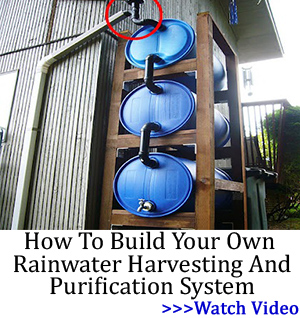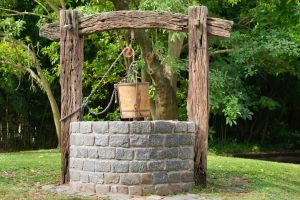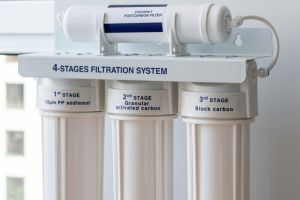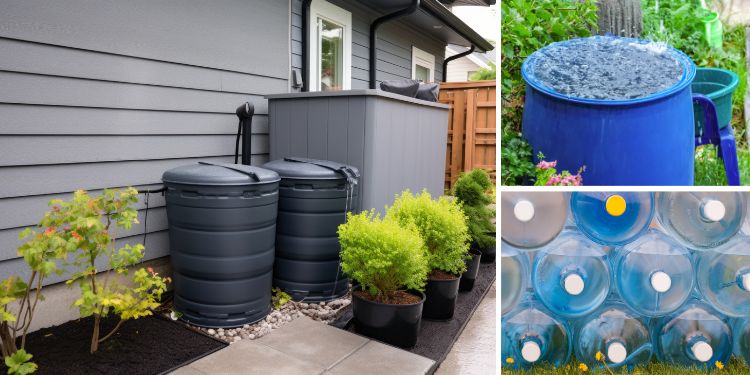Stockpiling plenty of water in preparation for a grid down disaster where the water quits running is crucial.
But there’s just one problem: your water stockpile is only good for as long as it lasts.
If your stockpile runs out and the grid is still down, what will you do then?
This is why you can’t consider yourself truly prepared when it comes to water no matter how much of it you have stockpiled.
There are two more vital skills that you need to learn in regards to water as well. These are:
Obtaining Water in a Crisis
You don’t just need to stockpile plenty of water, you also need to know how to collect more of it! The key is you want to have a replenishable source of water that ideally can continuously generate water for you. Three ways you can accomplish this are:
Rainwater Harvesting
Setting up a rainwater harvesting system is a lot easier than you may think.
All you really need is clean gutters and for downspouts to direct the water from rainfall down into food-grade water buckets at the bottom of your home.
 To give you an idea of how much rainwater you can expect to harvest, you can apply this formula: 1 inch of rain x 1 square foot = 0.62 gallons.
To give you an idea of how much rainwater you can expect to harvest, you can apply this formula: 1 inch of rain x 1 square foot = 0.62 gallons.
So, if you have a thousand square foot roof with which to capture rainwater, just one inch of rainfall can offer you up to 620 gallons.
That’s a lot of water, and it just goes to show why not setting up a rainwater harvesting system can be a huge missed opportunity.
Fog Catchers
Fog catchers are innovative devices designed to capture water droplets from fog and convert them into usable liquid water. It’s a good choice if you live anywhere that receives a lot of fog, such as high up in the mountains or near the coasts.
A fog catcher typically consists of vertical mesh panels or nets. As fog drifts through the mesh panels, water droplets become trapped and accumulate on the surface of the material. Gravity then causes the collected water to drip down into collection troughs or channels at the bottom of the nets, where you can collect it.
DIY Water Wells
If your property permits it, you should strongly consider digging a DIY water well to access groundwater on your property as well.
A well is simply one of the most reliable sources of water harvesting there is. While professional wells can be very expensive to dig, DIY water well kits provide you with a much cheaper option.
Related: Read This Before Stockpiling Water in Blue Barrels
Basically, you just need to excavate a hole around 20 to 25 feet deep into the ground where you can access groundwater, and then install a casing to prevent the well from collapsing over itself.

Then you’ll need to place a PVC pipe into the hole with a screen assembly at the bottom of the pipe that can filter though the water, and you can use pea gravel to fill the gaps in between the PVC pipe and the casing. Then you’ll need to install a cap assembly and pump handle over the PVC pipe to bring the water to the surface.
Atmospheric Water Generators
Atmospheric water generator devices, or AWGs, are devices that are designed to extract moisture from the air. Most AWG devices will draw in the water vapor from the air, use the process of condensation to turn it into a liquid, and then filter out the impurities before collecting it in a storage compartment.
AWGs are a great way to collect water if other water collection methods are not ideal. For example, they’re a great device to get if you live in an apartment or a condo where digging a water well or setting up a rainwater catchment system are simply not feasible.
Learning About Water Filtration and Purification
Drinking water that’s contaminated with bacteria or harmful substances can be more dangerous than not drinking any water at all.
That’s why you should take action to treat all water that you collect and harvest without exception.
Boiling
Boiling is perhaps the oldest water purification method there is, and it remains one of the simplest methods to this day.
To boil water, all you need is a container made out of a heat-resistant material. Fill the container with water, and then bring the water to a boil over a fire. Make sure that the water is boiling for a minimum of one minute before pulling it from the fire.
Filtration

Boiling is great for removing harmful bacteria that you can’t see, but it won’t get rid of the visibly offensive substances that you can see.
This is why you should combine boiling with filtration to make sure that the water you collect is absolutely safe to drink.
Two of the most common water filtration methods are:
Activated Carbon Filters
Activated carbon filters are porous and absorbent. They are most effective at removing impurities such as chlorine, volatile organic compounds (VOCs), and certain chemicals from water. You’ll usually find activated carbon filters used in pitcher filters, faucet-mounted filters, and under-sink filtration systems.
Ceramic Filters
Ceramic filters are made from porous ceramic material that trap sediment, bacteria, and other particles as water passes through. They are most commonly used in gravity filters and survival portable filtration devices for outdoor use.
If you want to make sure the water you’re using for your and you family is safe to drink, it’s best to filter it yourself. You can learn here a cheap and easy way to create an ingenious rainwater harvesting and purification system capable of storing 165 gallons of water.
UV Light Water Purifiers
UV water purifiers utilize ultraviolet light technology to effectively disinfect water by destroying microorganisms and bacteria. When water passes through a UV water purifier, it is exposed to UV light with a specific wavelength. This wavelength penetrates the cell walls of pathogens, which stops them from reproducing and causing infections.
UV water purifiers do not remove physical particles or dissolved contaminants from water. That’s why, like boiling, you should also use them in conjunction with filtering.
In short, making yourself truly prepared when it comes to water during a disaster means you need to accomplish three things:
- You need a strong stockpile of water.
- You need a means to harvest more water to replenish your stockpile.
- You need to know how to purify new water that you collect.
If all three of these things are not in order, you have work to do.
You may also like:
 10 Killer Trees You Should Never Have in Your Backyard
10 Killer Trees You Should Never Have in Your Backyard
The Only Way to Hide Your Water Supply When SHTF (Video)
What Is the Closest Power Plant to Your Home? Are You Living in the High-Risk Zone?
8 “Long Shelf Life” Foods That Will Actually Go Bad Faster Than You Think






















99th time this article is posted
LOL!
For Emergency Only !
A how to question. I have a well that is isolated to the sprinkler system only. Home is served by municipal water.
I understand the how to of the plumbing for the project but how do I get the sprinkler pump to run without also running one of the sprinkler zones ?
Im sure I will need to add a pressure tank and pressure switch.
Thanks Jim
WATAER… is an important subject and it needs to be repeated many times… Life at all does not exist without water… The property I now have, is an old farm house on a few acres next
to a forest full of game life, but it came with a Ground water well, and a 24/7 365 day Spring…. one of the many reasons I chose this place.. The property itself is on a community water supply, but having several backup plans, not to mention the early 1940’s house is totally guttered, so installing a rain catch system also fits into the equation…Now, all i have to do is get my butt in gear and put in a garden… I also have fruit trees, peaches and pears… East Texas…
a deep well is the only solution to water sustainability. 3 days without water will be the key for most. the looters will not last a week without clean potable water, for the lack of, or drinking from contaminated water will put them down quick and have others tied up caring for them. if one goes down it takes out three. one sick and two to care for them.
i plan to bug in for at least two weeks if things go SHTF long term, no one in or out, to let the sickness that they will have weed them out. the unprepared are not worth saving IMO. everyone has been warned. preparedness has been a lifestyle since the depression in our part of the world.
think about potable water as a barter item in a long term event.
Rain water is like the first snow fall, you don’t eat or drink it. It is washing out all the bad stuff in the air especially nowadays with the planes letting off chemicals in our air. Use good water filters for rainwater and for snow.
Yes there are toxic chemicals in the air. Chemical fertilizer spraying of farm crops that get into the groundwater table. Those that believe organic fruits and vegetables are completely safe of chemicals should see the whole picture. Many organic and chemical fertilizer farms are within the same areas. So there is a crossover of toxic chemical sprays.
Those that live in an area of plane flight routes do get fuel brown droplets from the passing jets and prop planes, not to forget the occasional toilet dumping that happens.
So there is some truth to the chem trail theory as mentioned in previous postings.
Commercial airliners do not have provisions for dumping lavatory contents in flight. That’s an “old wives tale”. It requires ground crew to empty what is sometimes nicknamed the “honey pot” in airliner toilets. The “honey pot” is only accessible from outside the aircraft. Military aircraft are the same way. The FAA kinda frowns on such activities as having anything exiting a civil aviation or commercial airplane in flight (outside of leaflets etc) even if it were possible to dump an airliner’s toilet in flight.
Likewise the deliberate distribution of any sort of harmful chemicals… those contrails you see in the sky are plain water vapor, historically trailing behind airplanes for as long as they’ve been able to climb to any sort of altitude where the temperature drops enough to condense the moisture in the exhaust… just like your car on those cold mornings with fog exiting the tailpipe.
Worry about other things, not airliner exhaust contrails.
What specious nonsense. Just goes to show the level of ignorance in this country.
Karen::Always check the sky for those deadly Chem Trails
before heading out to the Earth is Flat Society meeting.
It must be physically painful to be so crazy that you actually
believe that sh*t.
Especially when the real problems we face are so much more frightening, like the growing Bigfoot menace.
The real problems are the open southern border letting in military age people, possible terrorist groups mass forming an invasion army on American soil. Chinese nationals of unknown skills, hacking, sabotage on American cities and Chinese American owned farmlands, Chinese pot farms and meat processing companies.
The over looked Islamic pockets of decent we have in Dearborn Michigan and street, university campus protesters spewing hatred.
Chuck. Comments like that are not helpful. If you must berate someone, go over to CNN and have at it. I too believe there are chemtrails. If you have been out of Granny’s basement lately and into the woods you could see for yourself.
take the red pill chuck. Chem trails are real. do you not know how to look up
Chuck didn’t look an took the blue pill by mistake, he went from MAGA to Bidenomics. Find that red pill Chuck you can do it.
Chuck is having a Bad Bidenomics day today, LOL!
Harry:: The comment to Karen and obviously yourself is not
Intended to be helpful.
The sad truth is that those who believe in that shit are those
that are addicted to CNN/MSNBC and The View.
Crazies are like birds of a feather.They flock together.
Chuck, another troll, a true believer in Bidenomics will make America fine again in socialism your way. Quit drinking the Biden kool aid for starters.
the sad truth is you can’t look up. I don’t think anybody on this site is watching woke news.
I am lucky enough to have a creek running through my property. It’s about 100 yards from the house. In the event of a shtf scenario I hope to be able to make my way to the creek for at least a 5 gal bucket at a time.
I have a pond on my property. That, combined with a Berkey gravity filtration system is a key component to my water preps for drinking water.
Regarding DIY water wells, what is the guidance for determining WHERE to dig? Don’t want to dig 25′ deep holes all over my property willy-nilly trying to find the liquid gold.
Get some dousing rods and find the water.
What we all visibly exhale on a cold day is a chem trail.
The same water vapor, carbon dioxide, and other products of combustion, as well as nitrogen and other stuff we breathe in and ingest, condense to make the chem trail.
Methane and hydrogen organic, compounds generally come out the other end as “flatus.” Be sure to keep safe from the hydrogen hydroxide!
Rainwater harvesting is a great option for annual rains. The usual rain catching off roof shingles does carry atmosphere dirt from bird, rat, mice droppings and the chemicals from the shingles.
So water use for plants, gardens should be okay. For potable drinking water is where the use of water filtration comes to use in good times a water sanitation mistake, we have a cushion of medical help nearby. In a traumatic event to SHTF we will not be able to make a lot of mistakes in a grid down Swan event.
We have the added hazard and clear an present dangers of the open border illegals, known terrorist be let into America and added bonus of dumb low information voters. Thank you Bidenomics supporters for your help in DESOLATION of America as we know it!
I purchased a divice a few weeks ago where i can boil salt water with a small fire…get the water boiling ….and collect the steam that condenses and turns into water…then it flows into a container…..I’m just a few miles from Puget Sound in Wa. State . I have not tried it out yet….but should work .
Living in the Southwest, desert in Arizona, none of those SOLUTIONS, are really too helpful. I have a rain collection system, backed by 240gal storage … but rain is rare and intermittent. Atmospheric Water Generators, will work, but in low humidity, and dry soil, will not generate enough water to survive on … shallow or deep wells are not the answer … Personally, I’ve been contemplating creating chem trails over my property … hell, the government can do it … why can’t I?
In my area of the country, it is very humid in the summer. I have a dehumidifier I use in my mom’s house from time to time. It is amazing how much water it collects. It seems to me it would be drinkable after treatment. Or at the very least, used to water the garden. What do you all think?
Does it run on electricity? That’s going to be the problem or not right there. I live where it is very humid, good grief humid. If we’re having water issues is it because they’ve lost the power grid? If so the machine won’t be running.
Keep posting the article. It gets people thinking about it.
Be able to get it from more than one source.
Be able to store much of it.
Be able to boil it, filter it, distill it, and treat it – whatever must be done to make it safe to ingest.
Be able to make drinkable water from seawater, ditchwater, rainwater, flood water, lake water, whatever…
Agree.
There’s an artesian spring in the back yard, low side of the property. It comes up out of the ground through a pipe embedded into the aquifer and feeds a concrete cistern with a water level drain at about the 24″ level, which feeds a small pond which itself is the actual headwaters of a creek. When a hard rain falls, there are two other artesian springs that spout water out of the ground and run down channels into the same pond.
We never have shortages of water even if power fails and the well pump in the cistern has nothing to run it… I can walk down to the cistern with a batch of gallon jugs and cart water back to the house, no issues. I really need to set up a 220 inverter and a battery backup for powering the cistern pump during times when electric power fails and I’m feeling lazy and don’t feel like humping a batch of gallon jugs back to the house… but the cistern pump sucks a fair amount of power and an inverter with enough capacity would be expensive, as would be the battery backup to run it all. So, I’ll hump the gallon jugs. Easier than humping the Ma-Deuce… or the half of it I’d usually get stuck with.